
Mercury will show up in the evening sky the last few days of March. It’ll sweep past the sky’s 2nd-brightest planet, Jupiter, on March 27-28, 2023. Then Jupiter will drop into the sunset, but Mercury will go on to reach its greatest elongation on April 11. It’ll be the best Mercury elongation of the year for the Northern Hemisphere. As a bonus, as April passes, Mercury will be near dazzling Venus – the brightest planet – in the April evening sky.
Mercury near Jupiter in late March
Where to look: Look for Mercury in the sunset direction, as soon as the sky begins to darken. If you can’t see it, try sweeping for Mercury with binoculars. It might surprise you, and pop into view.
When to look: Mercury begins this evening apparition the last few days of March. However, it fades rapidly after elongation and it’ll disappear from view about the 3rd week of the month. Also, a very thin waxing crescent moon will be near Mercury – low on the horizon – on April 21, and may guide you to it around 30 minutes after sunset. What’s the last day you can spot elusive Mercury?
Greatest elongation: Is at 22 UTC ( 3 p.m. CDT) on April 11, 2023. At greatest elongation, Mercury is farthest from the sunset for this evening apparition, and 19.5 degrees from the sun.
Brightness at greatest elongation: Mercury shines at magnitude 0 so you can see it in twilight with averted vision.
Through a telescope at greatest elongation: Mercury appears about 40% illuminated, in a waxing crescent phase, and 8 arcseconds across.
Elongation constellation: Mercury is in the constellation of Aries the Ram. However, this dim constellation is lost in the twilight.
Note: As the innermost planet, Mercury is tied to the sun in our sky. As a result, it never ventures very far above the horizon after sunset. So, as soon as the sun disappears below your horizon, the clock starts ticking. Will you see the glowing point of light that is Mercury before it follows the setting sun?
Mercury elongation from the Northern Hemisphere
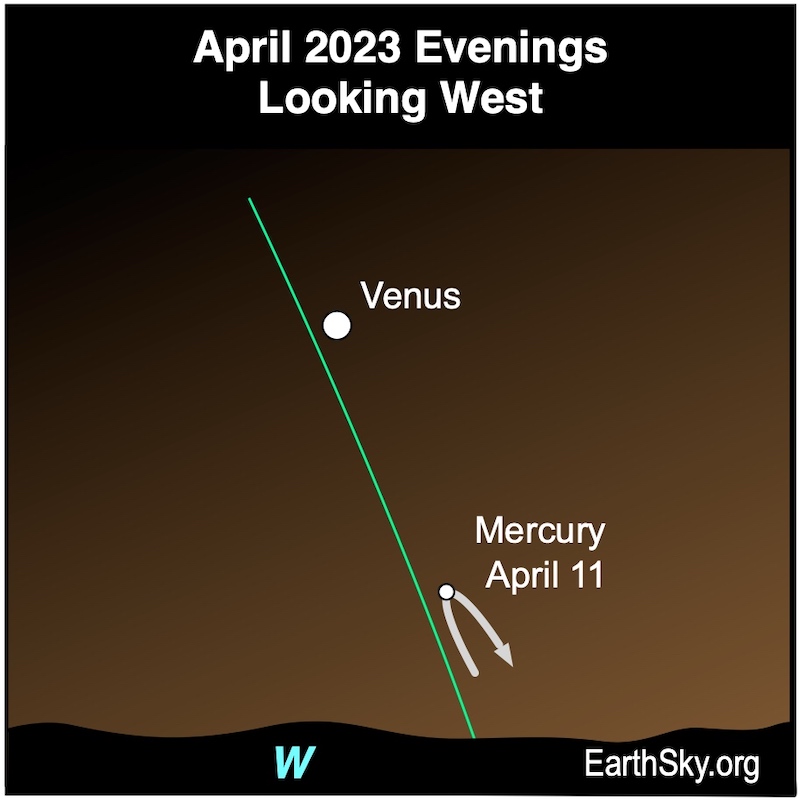
Mercury elongation from the Southern Hemisphere
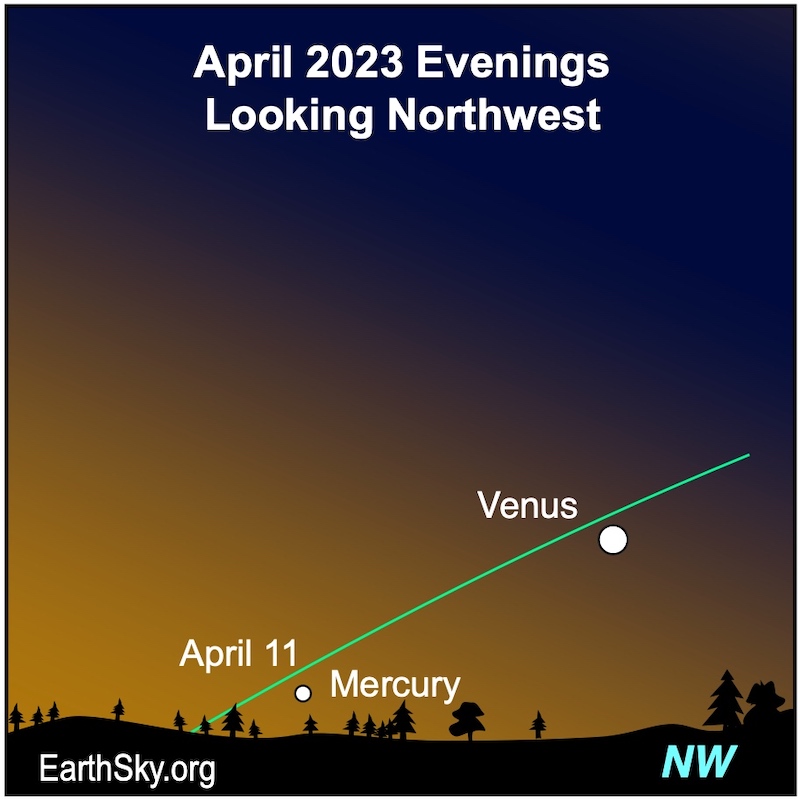
For precise views from your location, we recommend stellarium.org.
For precise sun and Mercury rising times at your location:
Old Farmer’s Almanac (U.S. and Canada)
Timeanddate.com (worldwide)
Stellarium (online planetarium program)
Mercury events in 2023
Jan 7, 2023: Inferior conjunction (races between Earth and sun)
Jan 30, 2023: Greatest elongation (morning)
Mar 17, 2023: Superior conjunction (passes behind sun from Earth)
Apr 11, 2023: Greatest elongation (evening)
May 1, 2023: Inferior conjunction (races between Earth and sun)
May 29, 2023: Greatest elongation (morning)
Jul 1, 2023: Superior conjunction (passes behind sun from Earth)
Aug 10, 2023: Greatest elongation (evening)
Sep 6, 2023: Inferior conjunction (races between Earth and sun)
Sep 22, 2023: Greatest elongation (morning)
Oct 20, 2023: Superior conjunction (passes behind sun from Earth)
Dec 4, 2023: Greatest elongation (evening)
Dec 22, 2023: Inferior conjunction (races between Earth and sun)

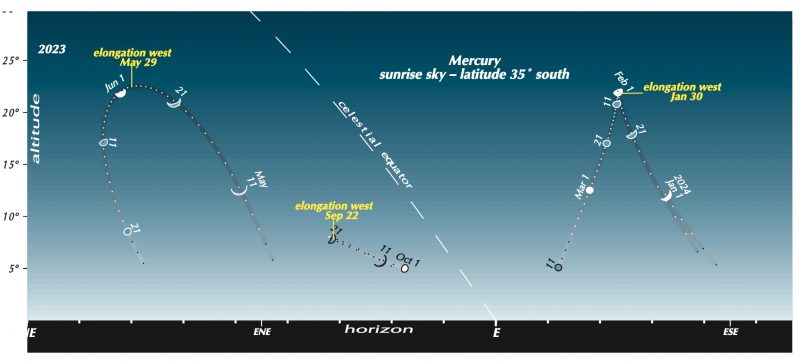
Heliocentric view of Mercury April 2023

Overview of Mercury Elongation
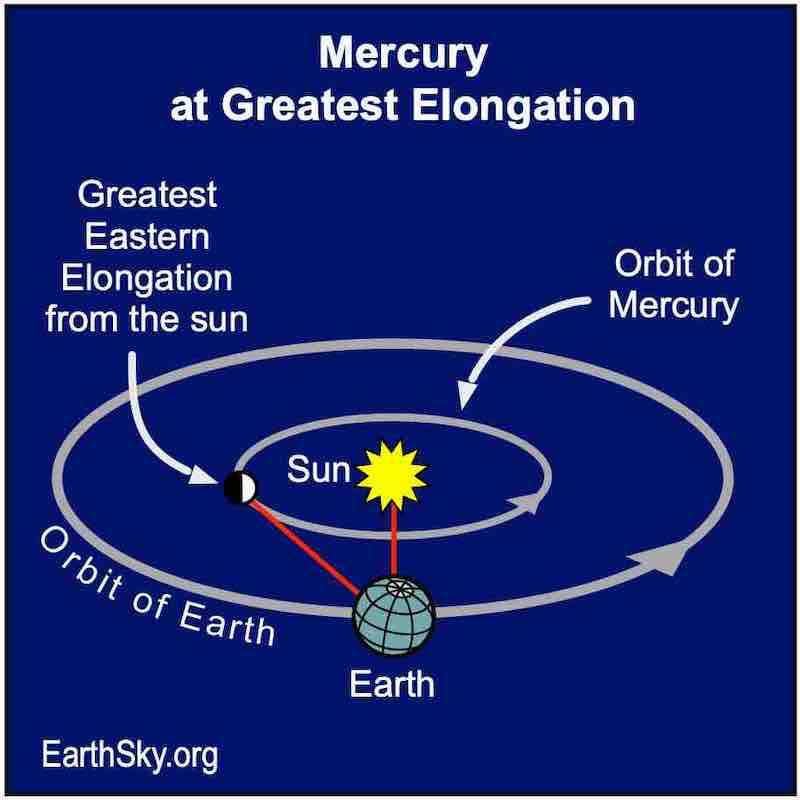
A comparison of elongations
As a matter of fact, not all of Mercury’s greatest elongations are created equal. Indeed, some are greater than others. Ultimately, the farthest from the sun that Mercury can ever appear on the sky’s dome is about 28 degrees. And the least distance is around 18 degrees.
Also, elongations are better or worse depending on the time of year they occur. So in 2023, the Southern Hemisphere had the best evening elongation of Mercury in January, 2023. And the Northern Hemisphere will have the best evening apparition in April.
In the autumn for either hemisphere, the ecliptic – or path of the sun, moon and planets – makes a narrow angle to the horizon in the evening. But it makes a steep slant, nearly perpendicular, in the morning. So, in autumn from either hemisphere, morning elongations of Mercury are best. That’s when Mercury appears higher above the horizon and farther from the glow of the sun. However, evening elongations in autumn are harder to see.
On the other hand, in the spring for either hemisphere, the situation reverses. The ecliptic and horizon meet at a sharper angle on spring evenings and a narrower angle on spring mornings. So, in springtime for either hemisphere, evening elongations of Mercury are best. Meanwhile, morning elongations in springtime are harder to see.
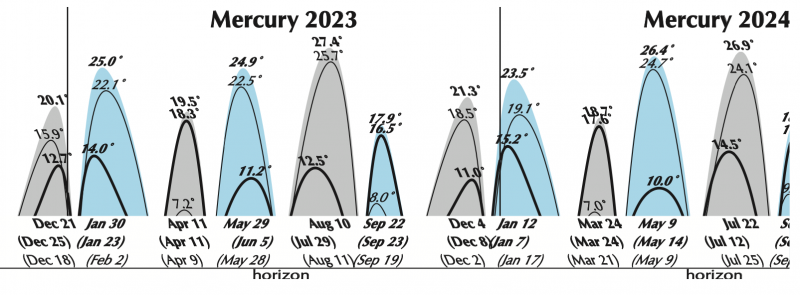
Photos from our community
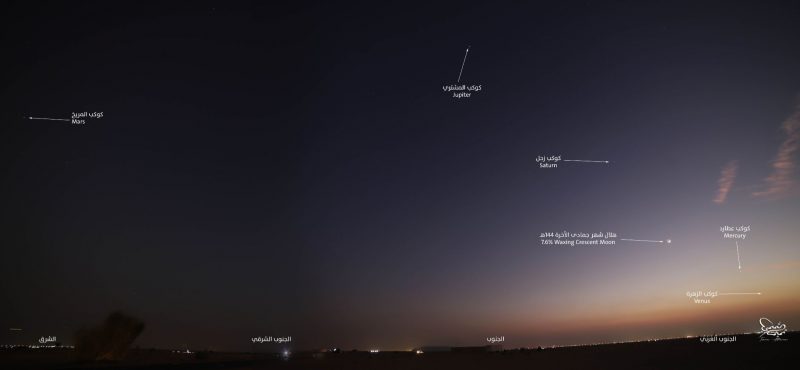
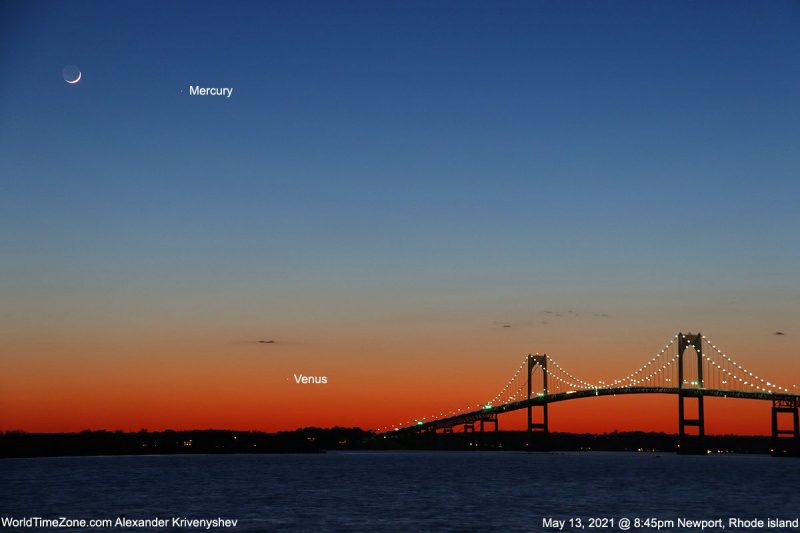
More photos from our community

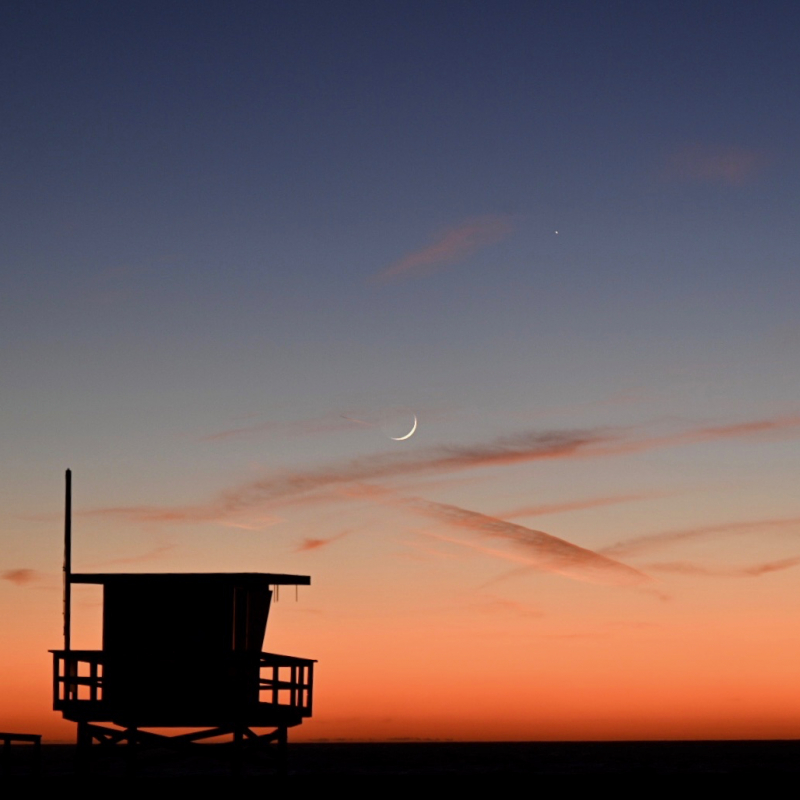
Submit your photos to EarthSky here.
Some resources to enjoy
Read about greatest elongations, superior and inferior conjunctions: Definitions for stargazers
Bottom line: Mercury reappears in the evening sky in late March. So, look in the sunset direction, as the sky is darkening. The planet reaches greatest elongation on April 11, 2023 and thin sinks out of view later in the month. By the way, bright Venus is near Mercury.
The post Mercury – near Jupiter – after sunset in late March first appeared on EarthSky.
from EarthSky https://ift.tt/F9kAiHW

Mercury will show up in the evening sky the last few days of March. It’ll sweep past the sky’s 2nd-brightest planet, Jupiter, on March 27-28, 2023. Then Jupiter will drop into the sunset, but Mercury will go on to reach its greatest elongation on April 11. It’ll be the best Mercury elongation of the year for the Northern Hemisphere. As a bonus, as April passes, Mercury will be near dazzling Venus – the brightest planet – in the April evening sky.
Mercury near Jupiter in late March
Where to look: Look for Mercury in the sunset direction, as soon as the sky begins to darken. If you can’t see it, try sweeping for Mercury with binoculars. It might surprise you, and pop into view.
When to look: Mercury begins this evening apparition the last few days of March. However, it fades rapidly after elongation and it’ll disappear from view about the 3rd week of the month. Also, a very thin waxing crescent moon will be near Mercury – low on the horizon – on April 21, and may guide you to it around 30 minutes after sunset. What’s the last day you can spot elusive Mercury?
Greatest elongation: Is at 22 UTC ( 3 p.m. CDT) on April 11, 2023. At greatest elongation, Mercury is farthest from the sunset for this evening apparition, and 19.5 degrees from the sun.
Brightness at greatest elongation: Mercury shines at magnitude 0 so you can see it in twilight with averted vision.
Through a telescope at greatest elongation: Mercury appears about 40% illuminated, in a waxing crescent phase, and 8 arcseconds across.
Elongation constellation: Mercury is in the constellation of Aries the Ram. However, this dim constellation is lost in the twilight.
Note: As the innermost planet, Mercury is tied to the sun in our sky. As a result, it never ventures very far above the horizon after sunset. So, as soon as the sun disappears below your horizon, the clock starts ticking. Will you see the glowing point of light that is Mercury before it follows the setting sun?
Mercury elongation from the Northern Hemisphere

Mercury elongation from the Southern Hemisphere

For precise views from your location, we recommend stellarium.org.
For precise sun and Mercury rising times at your location:
Old Farmer’s Almanac (U.S. and Canada)
Timeanddate.com (worldwide)
Stellarium (online planetarium program)
Mercury events in 2023
Jan 7, 2023: Inferior conjunction (races between Earth and sun)
Jan 30, 2023: Greatest elongation (morning)
Mar 17, 2023: Superior conjunction (passes behind sun from Earth)
Apr 11, 2023: Greatest elongation (evening)
May 1, 2023: Inferior conjunction (races between Earth and sun)
May 29, 2023: Greatest elongation (morning)
Jul 1, 2023: Superior conjunction (passes behind sun from Earth)
Aug 10, 2023: Greatest elongation (evening)
Sep 6, 2023: Inferior conjunction (races between Earth and sun)
Sep 22, 2023: Greatest elongation (morning)
Oct 20, 2023: Superior conjunction (passes behind sun from Earth)
Dec 4, 2023: Greatest elongation (evening)
Dec 22, 2023: Inferior conjunction (races between Earth and sun)


Heliocentric view of Mercury April 2023

Overview of Mercury Elongation

A comparison of elongations
As a matter of fact, not all of Mercury’s greatest elongations are created equal. Indeed, some are greater than others. Ultimately, the farthest from the sun that Mercury can ever appear on the sky’s dome is about 28 degrees. And the least distance is around 18 degrees.
Also, elongations are better or worse depending on the time of year they occur. So in 2023, the Southern Hemisphere had the best evening elongation of Mercury in January, 2023. And the Northern Hemisphere will have the best evening apparition in April.
In the autumn for either hemisphere, the ecliptic – or path of the sun, moon and planets – makes a narrow angle to the horizon in the evening. But it makes a steep slant, nearly perpendicular, in the morning. So, in autumn from either hemisphere, morning elongations of Mercury are best. That’s when Mercury appears higher above the horizon and farther from the glow of the sun. However, evening elongations in autumn are harder to see.
On the other hand, in the spring for either hemisphere, the situation reverses. The ecliptic and horizon meet at a sharper angle on spring evenings and a narrower angle on spring mornings. So, in springtime for either hemisphere, evening elongations of Mercury are best. Meanwhile, morning elongations in springtime are harder to see.

Photos from our community


More photos from our community


Submit your photos to EarthSky here.
Some resources to enjoy
Read about greatest elongations, superior and inferior conjunctions: Definitions for stargazers
Bottom line: Mercury reappears in the evening sky in late March. So, look in the sunset direction, as the sky is darkening. The planet reaches greatest elongation on April 11, 2023 and thin sinks out of view later in the month. By the way, bright Venus is near Mercury.
The post Mercury – near Jupiter – after sunset in late March first appeared on EarthSky.
from EarthSky https://ift.tt/F9kAiHW

Aucun commentaire:
Enregistrer un commentaire